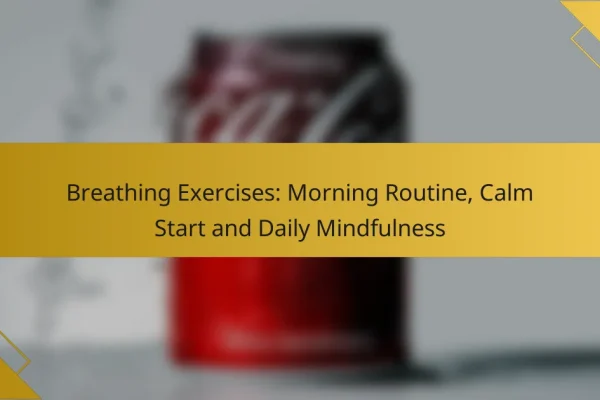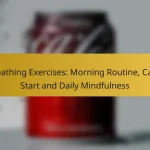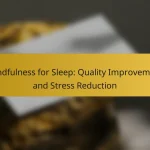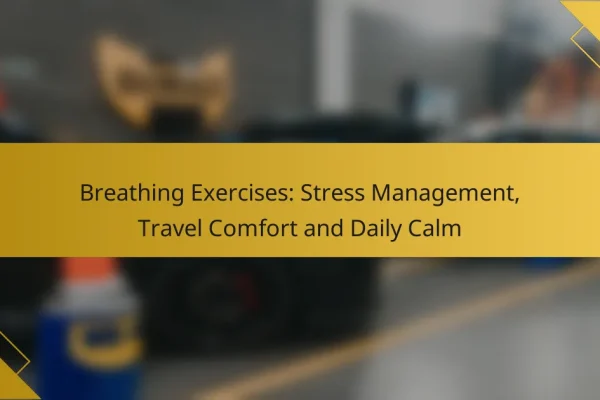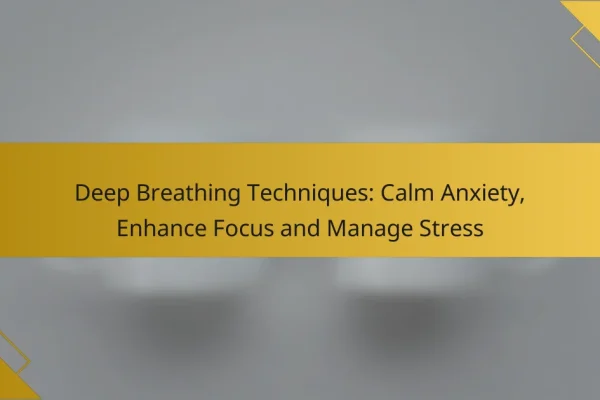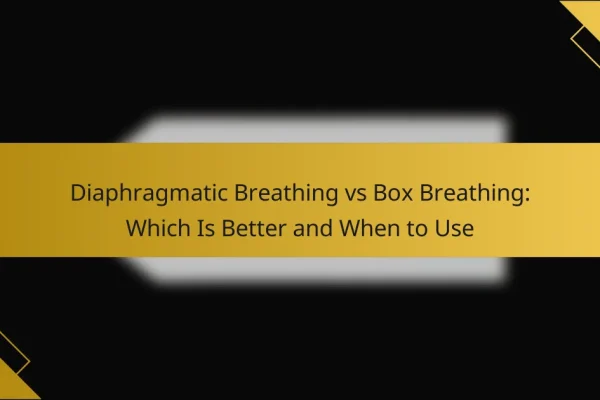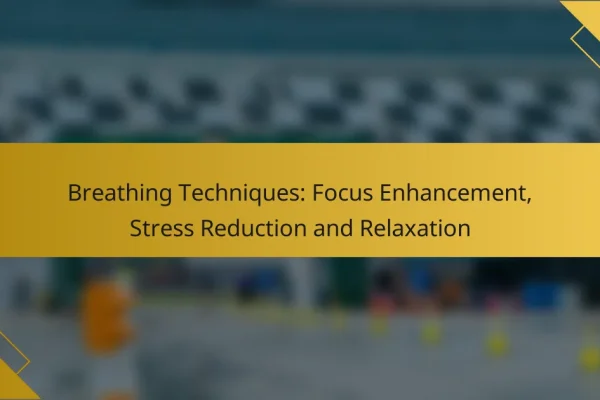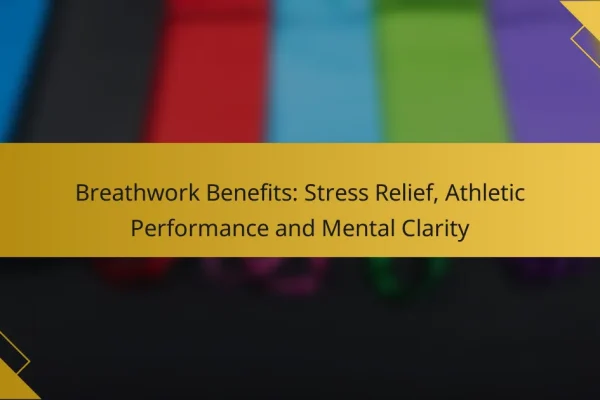What breathing techniques help relieve stress?
Breathing techniques that help relieve stress focus on controlling breath patterns to promote relaxation and reduce anxiety. These methods can be practiced anywhere and often require only a few minutes to be effective.
Diaphragmatic breathing
Diaphragmatic breathing, also known as abdominal or deep breathing, involves engaging the diaphragm fully. This technique encourages deeper inhalation and exhalation, which can lower heart rate and blood pressure, leading to a calmer state.
To practice, sit or lie down comfortably. Place one hand on your chest and the other on your abdomen. Inhale deeply through your nose, ensuring your abdomen rises while your chest remains still. Exhale slowly through your mouth. Aim for 5-10 minutes of practice daily.
Box breathing
Box breathing is a structured technique that involves inhaling, holding, exhaling, and holding the breath again for equal counts. This method can enhance focus and reduce stress by creating a rhythmic breathing pattern.
To perform box breathing, inhale through your nose for a count of four, hold the breath for four counts, exhale through your mouth for four counts, and hold again for four counts. Repeat this cycle for several minutes. This technique is particularly useful in high-pressure situations.
4-7-8 breathing
The 4-7-8 breathing technique promotes relaxation by extending the exhalation phase. This method can help calm the nervous system and is often recommended for those struggling with sleep or anxiety.
To practice, inhale quietly through your nose for a count of four, hold the breath for seven counts, and exhale completely through your mouth for a count of eight. Repeat this cycle four times. It’s advisable to practice this technique twice a day for optimal results.
Alternate nostril breathing
Alternate nostril breathing balances the body’s energy and promotes mental clarity. This technique is rooted in yoga and is believed to harmonize the left and right hemispheres of the brain.
To perform this technique, sit comfortably and use your right thumb to close your right nostril. Inhale deeply through your left nostril, then close it with your right ring finger. Open your right nostril and exhale through it. Inhale through the right nostril, close it, and exhale through the left. Repeat for several minutes.
Mindful breathing
Mindful breathing emphasizes awareness of the breath and the present moment. This technique can help reduce stress by fostering a sense of calm and presence.
To practice mindful breathing, find a quiet space and focus on your breath. Notice the sensation of air entering and leaving your body. If your mind wanders, gently bring your focus back to your breath. Aim for 5-10 minutes of practice, gradually increasing the duration as you become more comfortable.
How does breathing impact stress levels?
Breathing techniques significantly influence stress levels by promoting relaxation and reducing anxiety. Controlled breathing can lower cortisol, the stress hormone, and activate the body’s relaxation response, leading to a calmer state of mind.
Reduces cortisol levels
Deep and slow breathing can effectively lower cortisol levels in the body. When you engage in focused breathing exercises, it signals the brain to reduce the production of this stress hormone, which can help mitigate feelings of stress and anxiety.
Practicing techniques such as diaphragmatic breathing for just a few minutes daily can lead to noticeable reductions in cortisol. Aim for sessions lasting between 5 to 10 minutes, focusing on inhaling deeply through the nose and exhaling slowly through the mouth.
Enhances relaxation response
Breathing techniques enhance the relaxation response by activating the parasympathetic nervous system. This system counteracts the stress response, promoting a state of calm and relaxation throughout the body.
To maximize this effect, try incorporating practices like box breathing or 4-7-8 breathing into your routine. These methods involve specific patterns of inhalation and exhalation that can help you feel more centered and less stressed.
What are the benefits of breathing exercises?
Breathing exercises offer numerous benefits, including improved mental clarity, emotional regulation, and enhanced physical health. These techniques help to reduce stress and promote overall well-being by focusing on controlled breathing patterns.
Improves mental clarity
Breathing exercises can significantly enhance mental clarity by increasing oxygen flow to the brain. This boost in oxygen helps improve concentration and cognitive function, making it easier to focus on tasks.
Practicing deep breathing for just a few minutes can clear your mind and sharpen your thoughts. Techniques such as diaphragmatic breathing or box breathing are effective methods to incorporate into your daily routine.
Promotes emotional regulation
Breathing exercises play a crucial role in emotional regulation by activating the body’s relaxation response. This response helps to lower stress hormones and promotes a sense of calm, making it easier to manage emotions.
For instance, practicing slow, deep breaths can help reduce anxiety and improve mood. Regular practice can lead to better emotional resilience, allowing individuals to respond more effectively to stressful situations.
Enhances physical health
Engaging in breathing exercises can lead to various physical health benefits, including lower blood pressure and improved lung function. These exercises can also support better digestion and enhance overall vitality.
Simple techniques like pursed-lip breathing can improve airflow and oxygen exchange, which is particularly beneficial for individuals with respiratory issues. Incorporating these practices into your daily life can contribute to long-term health improvements.
When should you practice breathing techniques?
Breathing techniques should be practiced during key moments when stress levels rise or relaxation is needed. These moments include stressful situations, before sleep, and during meditation sessions.
During stressful situations
Practicing breathing techniques during stressful situations can help you regain control and calm your mind. Focus on deep, slow breaths to activate your body’s relaxation response, which can reduce feelings of anxiety and tension.
Consider using the 4-7-8 technique: inhale for 4 seconds, hold for 7 seconds, and exhale for 8 seconds. Repeat this cycle a few times to help alleviate immediate stress.
Before sleep
Engaging in breathing exercises before sleep can promote relaxation and improve sleep quality. Aim to practice these techniques about 15-30 minutes before bedtime to signal your body that it’s time to wind down.
A simple method is the diaphragmatic breathing technique, where you breathe deeply into your belly rather than your chest. This can help lower heart rate and prepare your mind for restful sleep.
During meditation sessions
Incorporating breathing techniques into meditation sessions enhances focus and deepens relaxation. Start your meditation by centering your breath, allowing it to guide your awareness and settle your thoughts.
Try to maintain a consistent rhythm in your breathing, such as inhaling for a count of five and exhaling for a count of five. This can help create a meditative state and enhance the overall experience.
What tools can assist with breathing techniques?
Various tools can enhance your breathing techniques, making it easier to manage stress. Breathing apps and wearable devices are popular options that provide guidance and feedback to improve your practice.
Breathing apps like Calm
Breathing apps, such as Calm, offer guided sessions that help users practice various breathing techniques. These apps typically include features like timers, reminders, and soothing sounds to create a conducive environment for relaxation.
When using a breathing app, consider your specific needs. For instance, if you prefer structured sessions, look for apps that offer a variety of guided exercises. Many apps also provide progress tracking, which can motivate you to maintain a consistent practice.
Wearable devices like Spire
Wearable devices like Spire monitor your breathing patterns in real-time and provide feedback to help you stay mindful of your breath. These devices often connect to a smartphone app, offering insights and reminders to practice breathing techniques throughout the day.
When choosing a wearable device, consider factors such as comfort, battery life, and compatibility with your smartphone. Some devices may also include additional features like activity tracking or stress level monitoring, which can enhance your overall wellness routine.
How can you incorporate breathing techniques into daily life?
Incorporating breathing techniques into daily life can significantly enhance your stress management. Simple practices can be integrated into your routine, making it easier to find moments for relaxation throughout the day.
Set reminders for practice
Setting reminders can help you establish a consistent breathing practice. Use smartphone alarms or calendar notifications to prompt you to take a few minutes for focused breathing, ideally several times a day.
Consider scheduling these reminders during natural breaks in your day, such as mid-morning or after lunch. This can create a habit that becomes a seamless part of your daily routine.
Integrate with yoga sessions
Integrating breathing techniques with yoga sessions can enhance both your physical and mental well-being. Focused breathing, or pranayama, is a key component of yoga that helps deepen relaxation and improve concentration.
During your yoga practice, pay attention to your breath as you move through poses. Aim for a slow, steady inhalation and exhalation, which can help you connect more deeply with your body and reduce stress levels.
